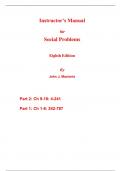Instructor’s Manual
for
Social Problems
Eighth Edition
By
John J. Macionis
Part 2: Ch 9-18: 4-241
Part 1: Ch 1-8: 242-787
, Part 2
Macionis, Social Problems, 8/e
CHAPTER 9
PHYSICAL AND MENTAL HEALTH
IM CHAPTER CONTENTS
Chapter Update
Author’s Note
Chapter Outline
Learning Objectives
Detailed Teaching Objectives
John’s Chapter Close-Up: Tracking the Trends
John’s Personal Video Selection
Research for a Cutting-Edge Classroom
Supplemental Lectures, Teaching Suggestions, Student Exercises, and Projects
Web Links
Essay Questions
Film List
CHAPTER UPDATE
The changes in Chapter 9 of this revision begin with a substantially revised discussion of the
latest policies and trends in the U.S. health care system including changes under the Trump
administration. There is also a major update to the discussion of HIV and AIDS in the United
States and around the world.
There are updates on longevity in the United States, including analysis by race, class, and
gender. New data on obesity are included as well as new data on the links between poverty and
health. The latest data also support discussion of infant mortality in the United States and
1
© 2020, 2018, 2015 Pearson Education, Inc. All rights reserved.
, Macionis, Social Problems, 8/e
globally. In addition new data on earnings of nurses and physicians in this country are presented;
finally, there are updates to the discussion of mental health on the campus.
AUTHOR’S NOTE
“Health” is something all understand but it is a concept difficult to measure. The chapter defines
health as a state of complete physical, mental, and emotional well-being. This definition suggests
that health has various dimensions involving not only our bodies but also our state of mind and
even our feelings. In addition, as the chapter explains, health is understood in the context of a
society’s cultural standards, which change over time.
Among the best measures that we might use to assess health are the following:
• Life expectancy: based on the simple argument that living longer means having better
health. National Map 9–1 on shows life expectancy for counties across the United States.
• Infant mortality: based on the claim that where children die, people do not have much
human security. Many health experts consider infant mortality the best single quantitative
measure of a nation’s health. Global data on infant mortality are found in Global Map 9–1.
This chapter provides a global survey of health that leads to these conclusions:
• Economic development matters: Low-income nations have shorter life expectancy and
higher infant mortality.
• Poverty threatens human health: Poverty means lack of nutrition, unsafe water, a high
level of infectious diseases, high risk of HIV/AIDS, and a dangerous environment.
• Nations have different systems to pay the costs of health care. How capitalist or socialist
an economy is has a lot to do with how these costs are paid.
The chapter also provides a close-up look at the health care system in the United States. Key
discussion points include the following:
2
© 2020, 2018, 2015 Pearson Education, Inc. All rights reserved.
, Macionis, Social Problems, 8/e
• High costs of health care
• Who pays the costs?
• Differences in health by class, ethnicity, race, and gender
The remaining part of the chapter deals with mental health and mental illness. This discussion
identifies types of mental disorders, critiques the concept of mental illness, and describes the
extent of mental illness with regard to class, race, and gender. Various treatment strategies are
discussed, and campus mental health is surveyed.
Finally, sociological theory is applied to health issues, and political analysis of problems
and solution concludes the chapter.
CHAPTER OUTLINE
Health and Illness: A Global Perspective
9.1 Contrast patterns of human health in high- and low-income countries.
• Health is defined as a state of complete physical, mental, and social well-being.
• High-Income Nations
o On average, people living in rich nations in North America, Western Europe, and
Japan are far healthier than those living in poor countries.
o Infant mortality rate is the number of babies, of every 1,000 born, who die before
their first birthday.
o Life expectancy at birth is the number of years, on average, people in a society
can expect to live.
o Chronic disease is an illness that has a long-term development.
o In most respects, being affluent is a lot better for human health than being poor.
But a higher standard of living does carry some health dangers of its own.
• Low-Income Nations
o Poor nutrition is one important factor that leaves low-income people—especially
children—vulnerable to disease. Another is the lack of safe drinking water, which
exposes poor people to disease-causing microorganisms.
o In poor nations, people typically die at any time in the life course from an acute
disease, an illness that strikes suddenly.
• Rich and Poor Compared: The AIDS Epidemic
o Social epidemiology is the study of how health and disease are distributed
throughout a society’s population.
o An epidemic is the rapid spreading of a disease through a population.
o AIDS: The Global View
3
© 2020, 2018, 2015 Pearson Education, Inc. All rights reserved.




